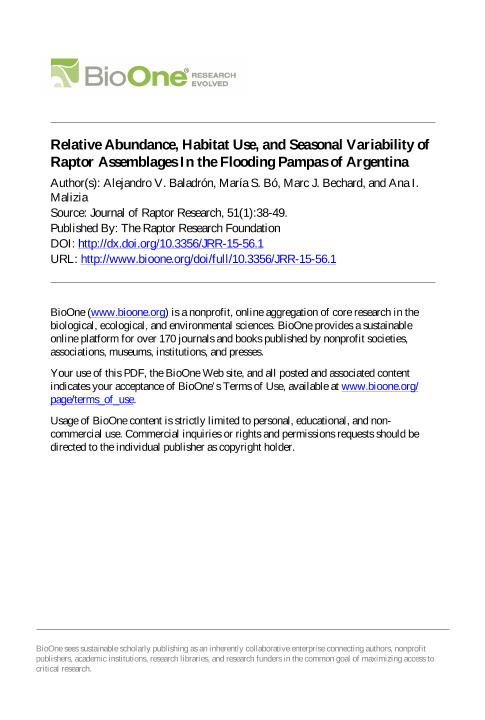Mostrar el registro sencillo del ítem
dc.contributor.author
Baladron Felix, Alejandro Victor

dc.contributor.author
Bó, Maria Susana

dc.contributor.author
Bechard, Marc J.
dc.contributor.author
Malizia, Ana Inés

dc.date.available
2018-11-20T17:05:20Z
dc.date.issued
2017-03
dc.identifier.citation
Baladron Felix, Alejandro Victor; Bó, Maria Susana; Bechard, Marc J.; Malizia, Ana Inés; Relative Abundance, Habitat Use, and Seasonal Variability of Raptor Assemblages in the Flooding Pampas of Argentina; Raptor Research Foundation; Journal of Raptor Research; 51; 1; 3-2017; 38-49
dc.identifier.issn
0892-1016
dc.identifier.uri
http://hdl.handle.net/11336/64738
dc.description.abstract
We evaluated the species composition, relative abundance, habitat use, and seasonal variability of raptor assemblages in the Flooding Pampas of Argentina, which represents the southeastern part of the biome known as the Rio de la Plata Grasslands. We conducted seasonal roadside surveys to detect raptors in modified and natural habitats over a 3-yr period from spring 2006 through autumn 2009. We classified raptor species according to their relative abundances and occurrence frequencies, and compared the assemblage composition among land-cover types (croplands, grazing fields, periurban areas, and grasslands) and seasons. The raptor assemblage in the Flooding Pampas comprised 16 species, representing approximately 43% of all raptor species in the biome. The Chimango Caracara (Milvago chimango) was the dominant species in all land-cover types and seasons. The Southern Caracara (Caracara plancus), American Kestrel (Falco sparverius), and Roadside Hawk (Rupornis magnirostris) were all abundant and very frequently observed species, whereas Burrowing Owl (Athene cunicularia), White-tailed Kite (Elanus leucurus), and Long-winged Harrier (Circus buffoni) were less abundant but recorded during most surveys. The remaining raptors (Aplomado Falcon [Falco femoralis], Cinereous Harrier [Circus cinereus], Short-eared Owl [Asio flammeus], Sharp-shinned Hawk [Accipiter striatus], and Snail Kite [Rostrhamus sociabilis]) were much less abundant in the study area. We also recorded four other raptor species (Variable Hawk [Geranoaetus polyosoma], Black-chested Buzzard-Eagle [G. melanoleucus], Striped Owl [Asio clamator], and Barn Owl [Tyto alba]), but only outside of the standard transect surveys. Species composition differed among land-cover types, but we detected no distinct overall seasonal patterns except that species diversity indices were lower in autumn and especially, spring. Milvago chimango was important to determine similarity in assemblage composition within land-cover types, but other less abundant species, such as C. plancus, A. cunicularia, and R. magnirostris, were more important to differentiate land-cover types based on raptor composition. Species diversity was highest in grazing fields and grasslands, and lowest in periurban areas. Our results suggest that although some raptor species appear to benefit from land-cover patterns in the study area, many other species may be threatened by the expansion of urban areas and agriculture in the Pampas region.
dc.format
application/pdf
dc.language.iso
eng
dc.publisher
Raptor Research Foundation

dc.rights
info:eu-repo/semantics/openAccess
dc.rights.uri
https://creativecommons.org/licenses/by-nc-sa/2.5/ar/
dc.subject
Agroecosystems
dc.subject
Argentina
dc.subject
Flooding Pampas
dc.subject
Grasslands
dc.subject
Habitat Use
dc.subject
Species Diversity
dc.subject
Urbanization
dc.subject.classification
Otras Ciencias Biológicas

dc.subject.classification
Ciencias Biológicas

dc.subject.classification
CIENCIAS NATURALES Y EXACTAS

dc.subject.classification
Otras Ciencias Biológicas

dc.subject.classification
Ciencias Biológicas

dc.subject.classification
CIENCIAS NATURALES Y EXACTAS

dc.title
Relative Abundance, Habitat Use, and Seasonal Variability of Raptor Assemblages in the Flooding Pampas of Argentina
dc.type
info:eu-repo/semantics/article
dc.type
info:ar-repo/semantics/artículo
dc.type
info:eu-repo/semantics/publishedVersion
dc.date.updated
2018-10-23T14:08:45Z
dc.identifier.eissn
2162-4569
dc.journal.volume
51
dc.journal.number
1
dc.journal.pagination
38-49
dc.journal.pais
Estados Unidos

dc.journal.ciudad
Lawrence
dc.description.fil
Fil: Baladron Felix, Alejandro Victor. Consejo Nacional de Investigaciones Científicas y Técnicas. Centro Científico Tecnológico Conicet - Mar del Plata. Instituto de Investigaciones Marinas y Costeras. Universidad Nacional de Mar del Plata. Facultad de Ciencias Exactas y Naturales. Instituto de Investigaciones Marinas y Costeras; Argentina
dc.description.fil
Fil: Bó, Maria Susana. Consejo Nacional de Investigaciones Científicas y Técnicas. Centro Científico Tecnológico Conicet - Mar del Plata. Instituto de Investigaciones Marinas y Costeras. Universidad Nacional de Mar del Plata. Facultad de Ciencias Exactas y Naturales. Instituto de Investigaciones Marinas y Costeras; Argentina
dc.description.fil
Fil: Bechard, Marc J.. Boise State University; Estados Unidos
dc.description.fil
Fil: Malizia, Ana Inés. Consejo Nacional de Investigaciones Científicas y Técnicas. Centro Científico Tecnológico Conicet - Mar del Plata. Instituto de Investigaciones Marinas y Costeras. Universidad Nacional de Mar del Plata. Facultad de Ciencias Exactas y Naturales. Instituto de Investigaciones Marinas y Costeras; Argentina
dc.journal.title
Journal of Raptor Research

dc.relation.alternativeid
info:eu-repo/semantics/altIdentifier/url/http://www.bioone.org/doi/full/10.3356/JRR-15-56.1
dc.relation.alternativeid
info:eu-repo/semantics/altIdentifier/doi/https://doi.org/10.3356/JRR-15-56.1
Archivos asociados
